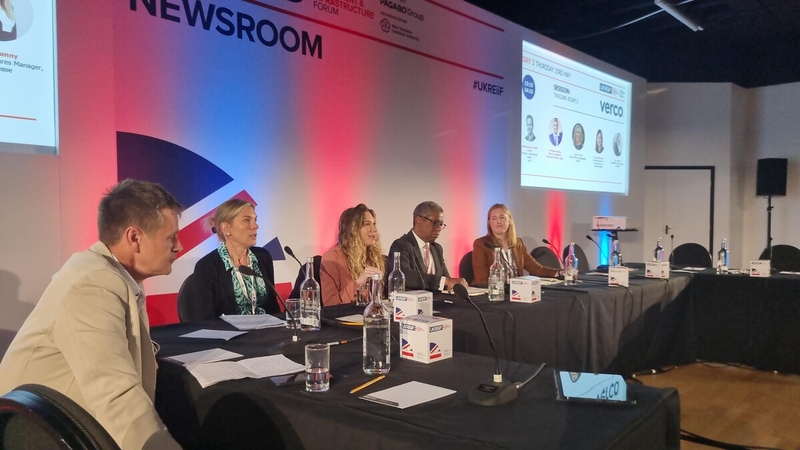Summary of the UKREiiF scope 3 panel session hosted by Verco

Verco hosted a panel session at UKREiiF on the topic of tackling scope 3. Verco’s Andries Van der Walt was joined by a panel of experts from UK and global real estate businesses. This insightful and engaging discussion is summarised below.
The scope 3 challenge- exploring the issues relevant to real estate.
Scope 3 covers all of the upstream and downstream emissions associated with the organisation’s activities. As a general rule, scope 3 is not under the direct control of the organisation and the organisation will have limited and varying degrees of influence. Typically for real estate it represents at least 80% of an organisation’s emissions. There may be uncertainty around scope 3, but that’s not a reason not to act, as our panellists demonstrated.
The panel experience of scope 3

Emma Williamson, Director and Global Lead on Net Zero Carbon Investment, M&G.
Emma is responsible for setting and overseeing M&G’s real estate business’s net zero strategy globally. She is working on operational scope 3 tenant investments which are the large majority of the scope 3 focus with an element of embodied carbon and development. There is a particular focus on tenant controlled buildings, generally on Full Repairing & Insuring Leases.

Dr Miguel Godfrey, Head of Sustainability, Government Property Agency.
Miguel is responsible for the portfolio of buildings occupied by civil servants including offices and warehouses among other asset types. His responsibilities include managing scope 1 and 2 emissions and to nudge government departments into taking action on scope 3. Miguel sets the strategies and standards, and ensures that there is sufficient capability within the workforce to follow these.

Ceire Kenny, Sustainable Futures Manager, Lendlease.
Lendlease’s target is to achieve absolute zero carbon for scopes 1, 2 and 3 by 2040- with no offsets. Ceire is the internal embodied carbon specialist and provides technical advice to get to net zero by 2040. She helps set up project roadmaps that are ambitious yet viable, as well as helping to deliver the roadmap and providing strategic advice.

Jennie Colville, Head of ESG and Sustainability, Landsec.
Landsec’s carbon reduction targets are validated by SBTi’s Net Zero standard. They produce c.300,000 tonnes of CO2 equivalent emissions annually. 90% of the emissions are scope 3. Of this, 40% is emissions from construction activities and 36% is from energy consumed in occupied spaces. The rest is from purchased goods and services. Our focus started with our Scope 1 and 2 emissions and we have a £135m Net Zero Transition Investment Plan in place to decarbonise our portfolio by 2030. In terms of scope 3, we’re focussing on the big contributors (embodied carbon and occupied spaces).
The panel discussion.
How did you implement your customer engagement programme for occupied spaces and what were the keys to success?
Jennie:
Verco has been supporting in the delivery of our customer engagement programme which is in it’s third year and part of our net zero transition investment plan. We started with office customers, because we purchase the energy on their behalf, we have the data and understand where energy has been consumed. We undertook deep dive energy audits and met with key stakeholders to produce a report which shows them how they can reduce energy. This was highly valued by our customers. Now the challenge is turning the action points into deliverables - helping them to overcome the barriers to implementation.
How do you go about engaging large numbers of suppliers to take action on scope 3?
Ceire:
99% of our emissions sit in scope 3. The large majority of that comes from our purchased goods and services, for example building materials, so there’s no way we can reach the target without supply chain engagement. We find the individual projects are good but short-term. So the long-term view is important, looking at when suppliers will meet their targets and asking key questions: Are we going to reach the finish line at the same time? What they are doing about it and what can we do to work with them and support and work collaboratively? Innovative solutions include more efficient design, optimising production methods for reduced carbon emissions and refining composition of raw materials.
I’d like to open the question up to other panellists- what innovative solutions have been game-changers for scope 3?
Jennie:
We specify low-carbon cement replacements such as Ground Granulated Blast-furnace Slag (GGBS), a by-product of steel manufacturing but we are aware that as steel decarbonises, the availability of this is decreasing. Therefore, we’re also investigating other low-carbon cement replacements, such as Concretene – an innovative new material which uses graphene to improve the strength of concrete, reducing the amount of material used and the need for steel reinforcement.
Miguel:
We set embodied carbon targets based on the LETI guidelines but had initial push back on these as being too ambitious and with a need for more evidence of how suppliers will get there. I showed them examples of small step innovations where embodied carbon is reduced, techniques and alternative materials that can be used to continuously improve and deliver on targets. For example, continuous pour concrete, laminated wood, setting expectations that materials that are being used will be re-useable. This helped build confidence in our ability to meet the targets.
As a global operator, what are the key issues for collaboration?
Jennie:
I agree data is a massive issue. Another challenge is, once we get that data, how are we going to use it and encourage action. How are we going to incentivise occupiers to meet targets?
What do you think is the role of government and regulation in this and what is your view on data transparency?
Miguel:
It’s important for us to become members of organisations such as the BBP, UKGBC, IEMA so that in our sustainability advisory role we are open and transparent about what we do, opening ourselves up for criticism and speculation. Making ourselves much more data driven and using this along with collaborative expertise to inform the way forward.
With the upcoming general election- if you could ask the new government to change one thing, what would that be?
Miguel:
One consistent message, one consistent target so we can focus on a clear goal.
Ceire:
Clear goalposts as a requirement rather than optional.
Jennie:
Mandatory scope 3 emissions reporting and transition plans, but this should include support for SMEs to help them do this.
How helpful are industry reporting schemes and frameworks in terms of including scope 3.
Jennie:
I think frameworks are extremely helpful, they give comparable data. Everyone has a net zero target but they are all very different. That’s where SBTi’s net zero global standard has come to the fore. However there is a SME caveat. The UKGBC standard is useful to define what a net zero building means and levels the playing field.
Audience questions-
Do you have a methodology for assessing your supplier route to net zero (how far they are on that journey)?
Ceire:
We work with them on the timings of their plan, looking at when something is going to be implemented and how. We also work with them on individual projects, how they are progressing and how to support them.
Are you validating supplier data to understand how robust that is?
Miguel:
Our robust procurement processes ensure our suppliers have the right accreditations in place to deliver what is needed.
Sustainable choices can impact on project timing, how do you tackle this challenge?
Ceire:
Projects are reviewed in terms of cost, carbon and programme to see how the different options will impact on the overall programme. We then make decisions based on this.
Jennie:
For each project, we map out a waterfall diagram which looks at individual projects and we examine the projects in terms of carbon, cost and time.
Is there a missing piece in selling the benefits of standing assets?
Jennie:
Yes, we need to make refurbish schemes appealing to our tenants. Retrofit first, but not retrofit only.
Miguel:
Yes, using existing buildings fits with the use of beautiful buildings and we just can’t get rid of our legacy estate, 80% of our estate will still be our estate in 2050 so we need to work on what we have.
Do you find there is a requirement to spend a great deal of money in order to deliver a net zero carbon building - or are you experiencing a change?
Ceire:
Sustainable buildings don’t always have to cost a huge amount of money, making efficiency changes and using different materials can reduce the volume of material needed without an impact on cost, but there will always be a ‘first mover tax’ and until lots of people are doing it, there will often be a premium. You don’t get something for nothing.
Miguel:
We examine the cost implication of everything we do in a project so that we can make good decisions based on both carbon and cost. For example continue to sweat the life of gas boiler to allow heat pumps to decrease in cost and improve in efficiency over time. This ensures we get value for money as well as carbon reduction over the course of our net zero pathway.
If you could fix one thing, what would that be?
Miguel:
Recognised protocols where everyone will acknowledge the result of analysis.
Ceire:
Every supplier to have an EPD overnight.
Jennie:
Financial incentives for organisations to take action.
Sum up:
- Taking practical actions on Scope 3 is critical. The fact that over 90% of the emissions of our panellists’ organisations is in scope 3 highlights the importance of this area.
- Consistency is important - in how the government approaches this and organisations with their customers and supply chain.
- Start with the biggest rocks, move the things that make the biggest impact.
- Little steps of innovation make a huge difference.
- A culture of collaboration is important and the net zero building standard is going to be key and much needed in the industry.
- We have some models we can follow from France and other countries, we have lots of issues to solve together but there is huge momentum and commitment to tackle this important issue.
Watch a recording of the UKREiiF session
Watch the webinar: Solid strategies to conquer scope 3 in real estate.
In this on-demand webinar, our senior real estate experts explore the most material scope 3 emission sources for the sector, highlighting the opportunities and approaches that work.